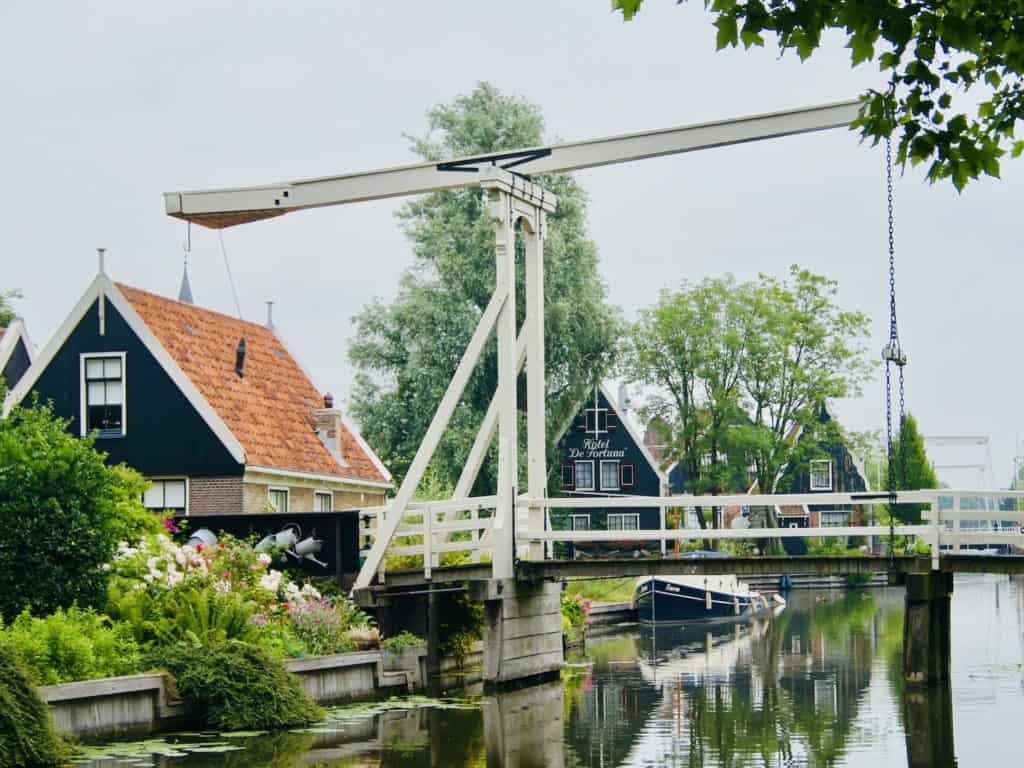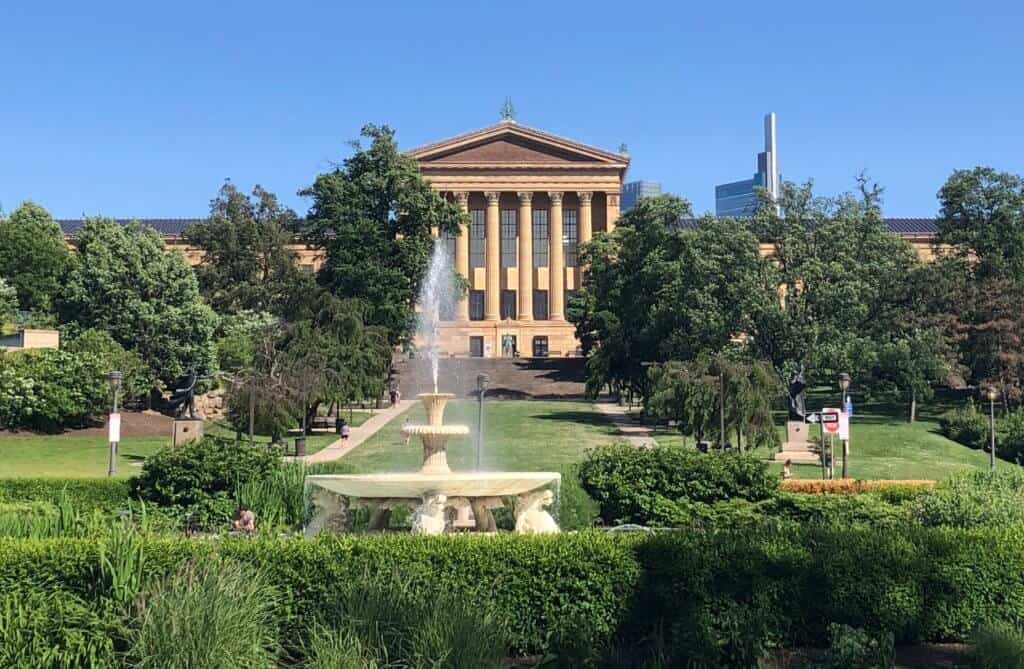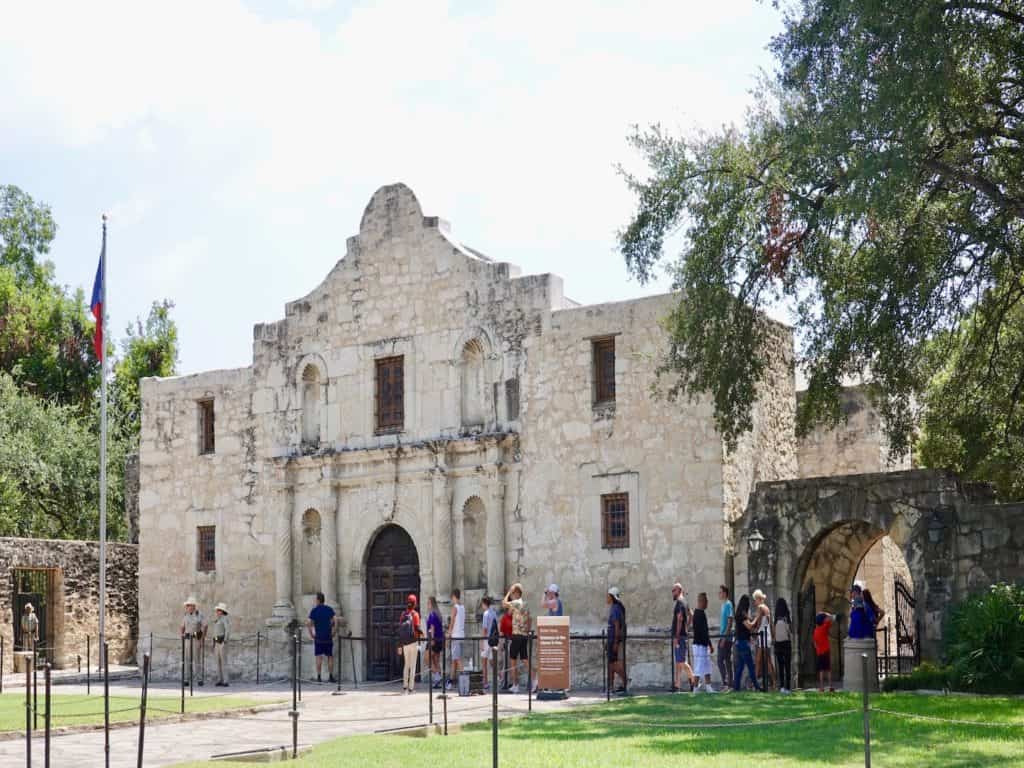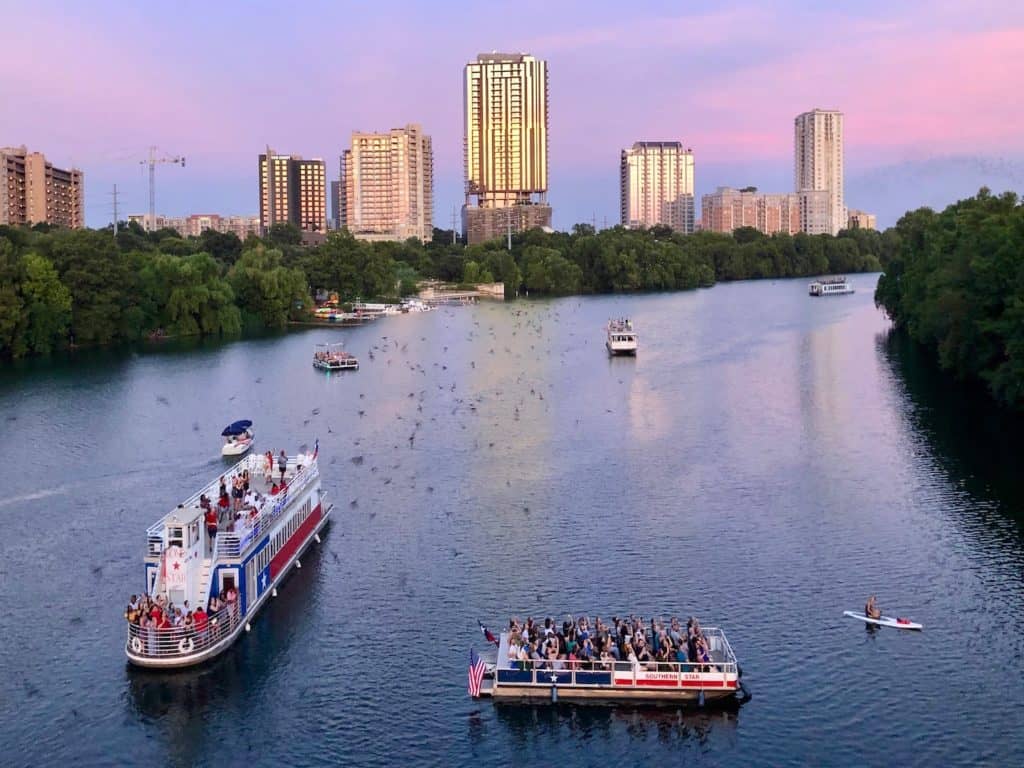Mention visiting the Chesapeake Bay area of Maryland, and many think of the Eastern Shore. But wait, there’s more! In fact, there’s a lot to enjoy along the western shore of southern Maryland, as well. Top of many visitors’ lists is the amazing Historic St. Mary’s City, a living museum and active archeological site, that tells the tale of an abandoned 17th-century English settlement, the first in Maryland and its first capital.
On the western shore of southern Maryland you’ll find incredible history and enjoyable outdoor experiences:
- colonial history (Historic St. Mary’s City & St. John’s Site Museum);
- maritime history (Calvert Marine Museum and four lighthouses);
- aviation history (Patuxent River Naval Air Museum);
- natural history dating back millions of years (fossils at Calvert Cliffs);
- outdoor walks/hikes in beautiful natural settings (Calvert Cliffs State Park, Historic St. Mary’s City, Point Lookout State Park); and
- delightful dining choices at Solomons Island.
Read all about it!
1. Historic St. Mary’s City & St. John’s Site Museum
Historic St. Mary’s City
Over four centuries ago, British settlers landed in this part of Maryland, beginning the first European settlement and capital in Maryland. In fact, it was the fourth oldest permanent English settlement in the United States. Today Historic St. Mary’s City is an 800-acre living museum and archaeological park (at the site of St. Mary’s Fort). The city disappeared after 60 years of thriving, due to the location change of the capital; the land was then largely converted to farmland, and then rediscovered decades ago after a bit of research and archeological digs.
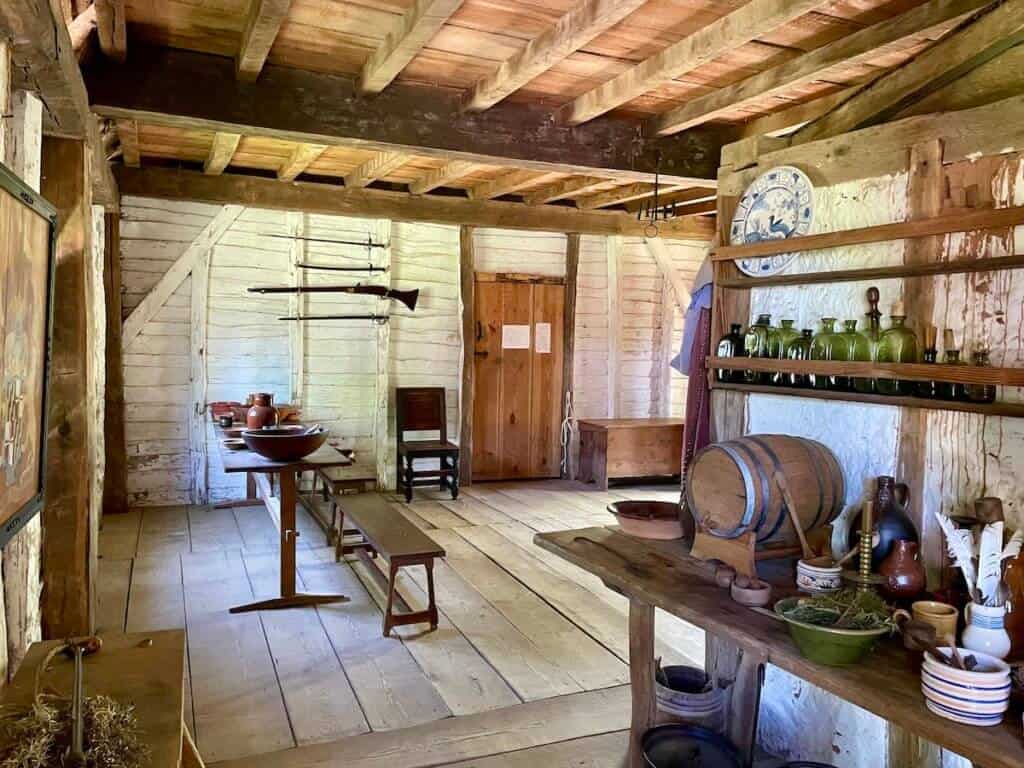
Plan on starting your visit at the visitor center. It has a short video and plenty of helpful background information to set the stage for your visit. The impressive amount of informational signage throughout the outside areas helps to explain how the settlers lived, worked, and worshiped. Visitors walk along the paths of this outside museum, taking in the original and reconstructed buildings. Costumed historical interpreters are on hand throughout the park to provide context to the buildings and what you’re viewing.
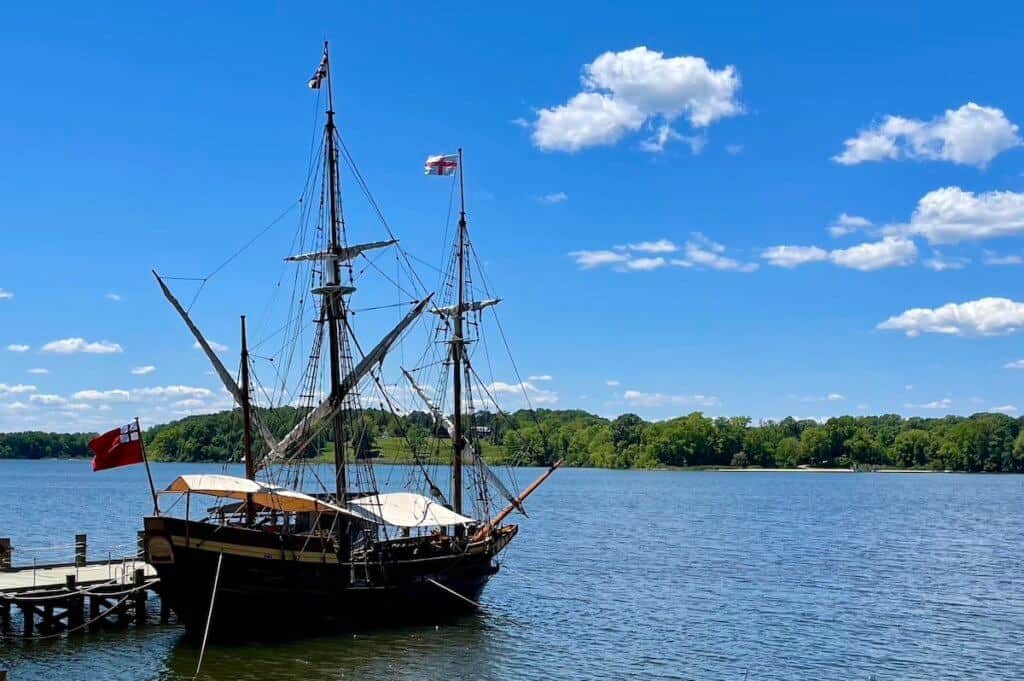
Some Highlights of St. Mary’s City Today
The State House and the Chapel sit on opposite ends of the town, symbolizing the separation of church and state that was the hallmark of the early days of this settlement. Both are reconstructions today but are true to the original based on archaeological and document research. Inside the chapel are three lead coffins that were unearthed by archeologists accompanied by a detailed explanation of their suspected origins.
The original Mackall Barn, the oldest barn in the state, served as a granary and a tobacco barn. Inside you’ll see and learn about (from detailed informational signage) how the barn was constructed. I found it interesting to learn how the carpenters notched numerals in the wooden beams to make it easier to match up the different parts of the structure.
Several other buildings include Smith’s Ordinary (a 17th-century public inn), Van Sweringen’s Inn (a private inn designed for and appealing to wealthy lodgers), the Print House, and Cordea’s Hope (a storehouse).
The Maryland Dove ship is a reproduction of one of the two ships that brought the settlers to this area from England. Climb aboard and learn more about life while sailing across the Atlantic Ocean. A new Maryland Dove reproduction, currently being built in St. Michael’s on the Eastern Shore, will replace this one (pictured above in the spring of 2021) that has been at Historic St. Mary’s City for decades. Making its debut at Historic St. Mary’s City in the fall of 2021, the new ship was designed to be even more historically accurate given fairly recent research and discoveries.
The Woodland Indian Hamlet shows how the Yaocomaco Indians might have lived in the area in the 17th century. One thing I learned while visiting was that the Yaocomaco people lived in a matriarchal society, one in which the females were the heads of the households.
Godiah Spray Tobacco Plantation is a short drive or walk away and features the home of the plantation owner (with a costumed museum interpreter), a tobacco barn, a period garden, and livestock. (Because of the livestock, no dogs are permitted on these grounds.)
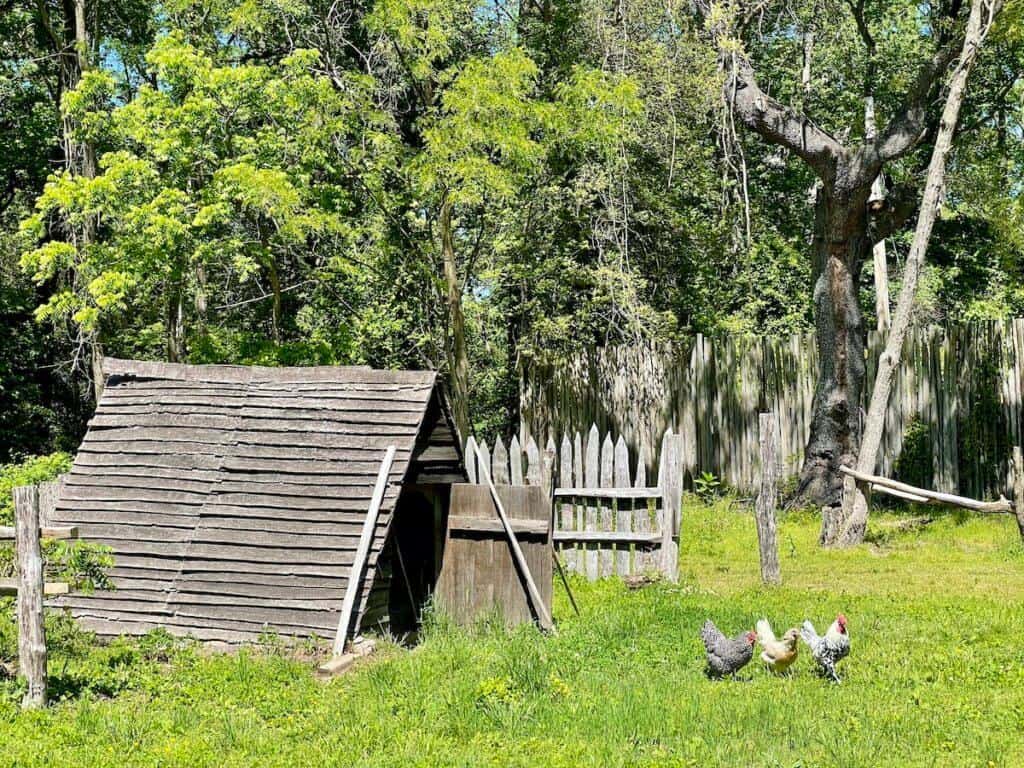
Religious Freedom in Early Maryland
One of the hallmarks of this settlement in the 1600s was, for that time period, its liberal stance on religious freedom, allowing Catholics and Protestants to worship freely. Two ships, the Ark and the Dove, ferried about English 400 settlers and indentured servants along with their provisions to what we now call Maryland, arriving in March 1634. The Indians occupying the land sold a large parcel of it to the English settlers who set about to build a town.
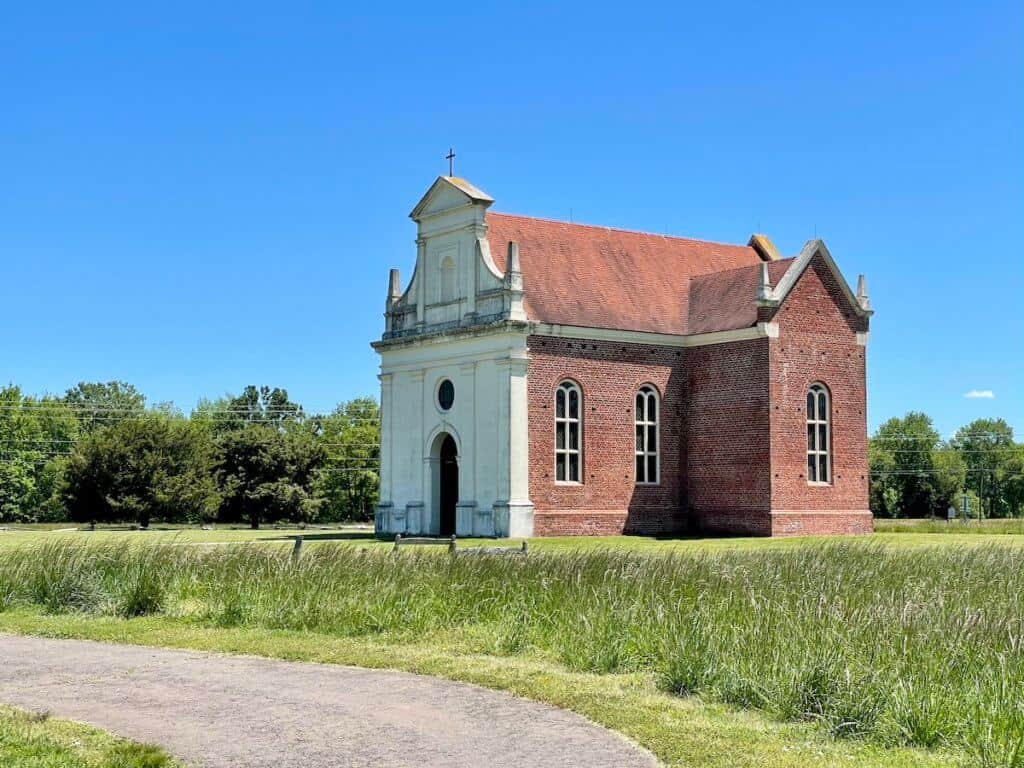
Town Layout
St. Mary’s City’s town plan called for the state house (built in 1676) and church (built around 1667) to be separate from each other but both equidistant to the center of town, the hub of town life.
The End of Religious Freedom
As a ripple effect of the English Civil War, in 1689 the English King William and Queen Mary, Protestants, took control of the colony from Lord Baltimore, a Catholic, and gave it to Sir Copley, who was named as the first royal governor. As a result, this era of religious freedom ended. For example, the only location Catholics were then allowed to worship was in their own homes.
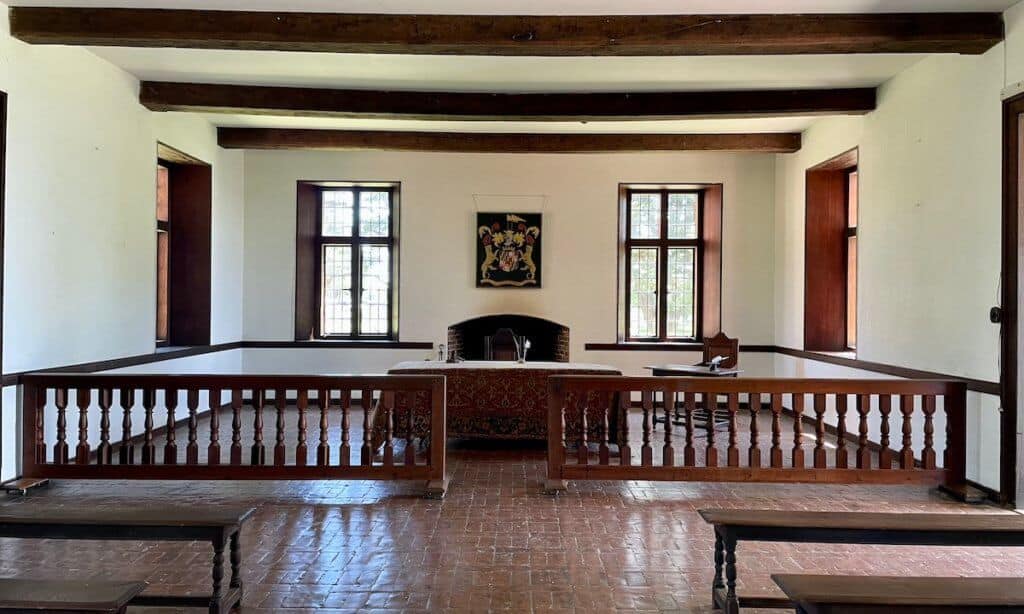
The City’s Demise
As a result of Sir Copley being named as the first royal governor and the resulting dramatic curtailment of religious freedom, it was decided that a clean break from the past was necessary. Therefore, the capital of the Maryland colony was moved from St. Mary’s City to Annapolis (then a new port city) in 1695. This meant the end of St. Mary’s City since many townspeople moved to the colony’s new governmental — and soon-to-be commercial center. As most people left, the buildings were torn down, and the land was converted to farmland. It was only after years of careful archaeological research that this historically important and, therefore, special place lives on for today’s visitors.
A Virtual Visit
To gain a better understanding of this amazing place and whet your appetite for your visit, consider viewing virtual tours of Historic St. Mary’s City.
Leashed dogs are allowed in the main part of the outdoor museum. No dogs are allowed at the plantation. Admission charged. The main entrance and visitor center: 18751 Hogaboom Lane, St. Mary’s City, MD / 240-895-4990
St. John’s Site Museum
A short drive from Historic St. Mary’s City is St. John’s Site Museum, on the campus of St. Mary’s College. The original structure was built in 1638 for John Lewger, the provincial secretary. Inside the museum, visitors can view the actual archaeological excavation as well as numerous informational exhibits and artifacts. This is definitely worth a stop after visiting Historic St. Mary’s City. On the grounds of St. Mary’s College.
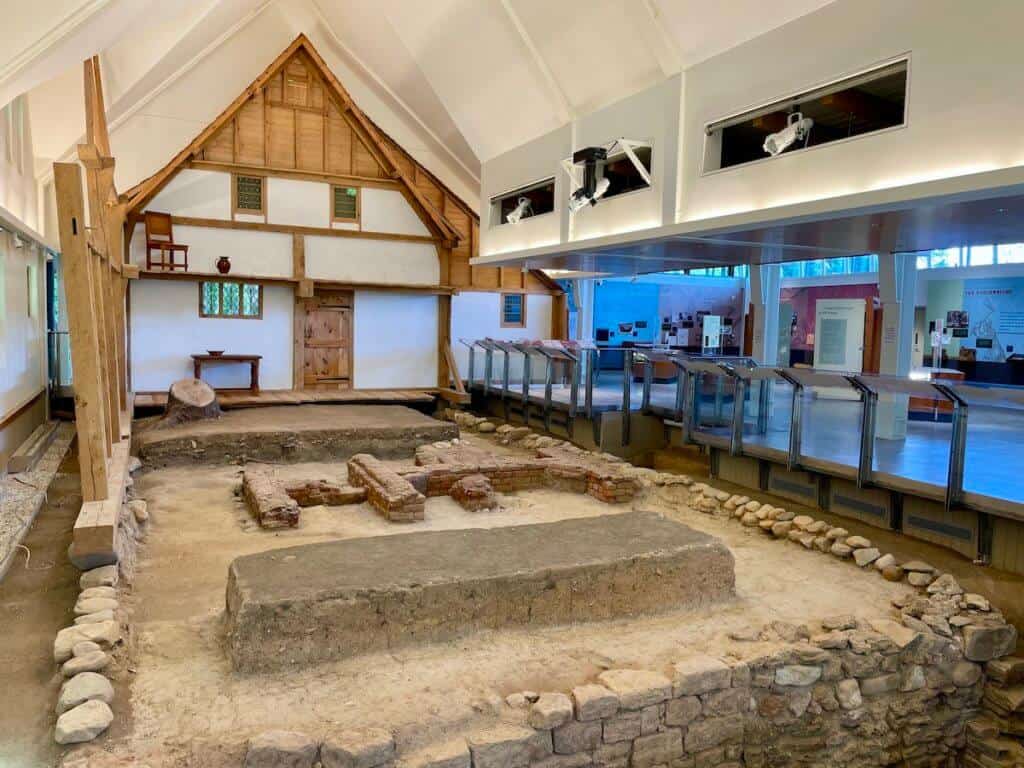
2. Calvert Marine Museum & Drum Point Lighthouse
The Calvert Marine Museum is a great stop on your southern Maryland visit as it tells the story of the area so well. In the museum are exhibits and displays of fossils found at nearby Calvert Cliffs State Park, the area’s maritime history, and some creatures (including otters) that call this coastal region home.
In addition to the main exhibition hall, there are several other buildings at the museum:
- the Drum Point Lighthouse;
- an outside shed housing a number of old wooden boats;
- a woodcarving shop where artisans construct boat models:
- an oyster packing house; and
- aboard a converted oyster boat built in 1899, the Wm B. Tennison, that will take visitors on an hour’s ride to take in the sights and hear about local lore.
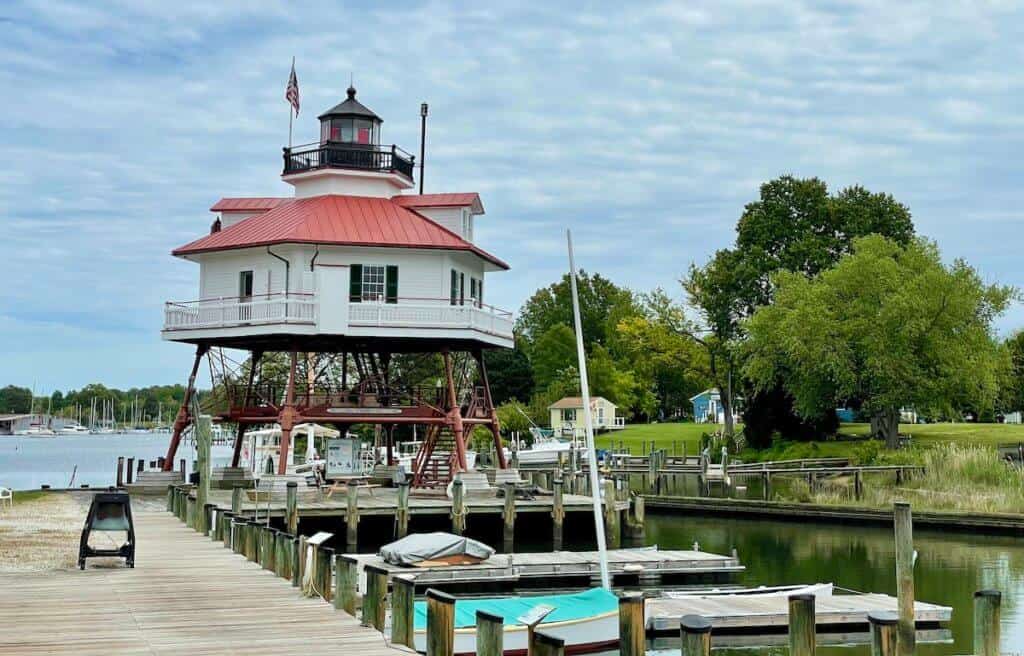
One of the highlights of our visit was being able to go inside the 1883 Drum Point Lighthouse. (After being decommissioned decades ago, it was relocated to the museum for visitors to enjoy.) Climb up the ladder and walk through this screw pile, hexagonal lighthouse that once helped boat captains ply the Chesapeake Bay waters safely. It has been restored and furnished in period pieces, making it possible to visualize a little about what life must have been like for the lighthouse keepers.
Admission charged. 14200 Solomons Island Road, Solomons, MD / 410-326-2042
3. Lighthouses of Southern Maryland
Southern Maryland boasts some interesting beacons of light that helped mariners navigate the waters of the Chesapeake Bay.
- The Drum Point Lighthouse is the only one of the four that was built using a hexagonal screw pile design that served as a lighthouse and a home for the Keeper as it was positioned in the bay. It’s located at the Calvert Marine Museum.
- The remaining three — Cove Point, Piney Point, and Point Lookout — are traditional cone-shaped structures, positioned on land, and were tended by keepers who lived in a house on the property.
- Visitors can climb into two of these to take a look around: Drum Point Lighthouse and Piney Point Lighthouse.
Cove Point Lighthouse
Cove Point Lighthouse was Maryland’s oldest lighthouse in continuous use. Constructed in 1828, the lighthouse stands 40 feet high and served as a sentry along one of the narrowest parts of the Chesapeake Bay. In addition to the lighthouse, the property has several buildings including the 200-year-old Keeper’s House (now available for rent for a sojourn along the water’s edge) as well as the 1901 Fog Signal Building and a platform where visitors can view the iconic Calvert Cliffs from a distance. The lighthouse was automated in 1986, eliminating the need for a keeper to tend to it. The nearby Calvert Marine Museum now oversees the four-acre site and manages vacation rentals of the Keeper’s House.
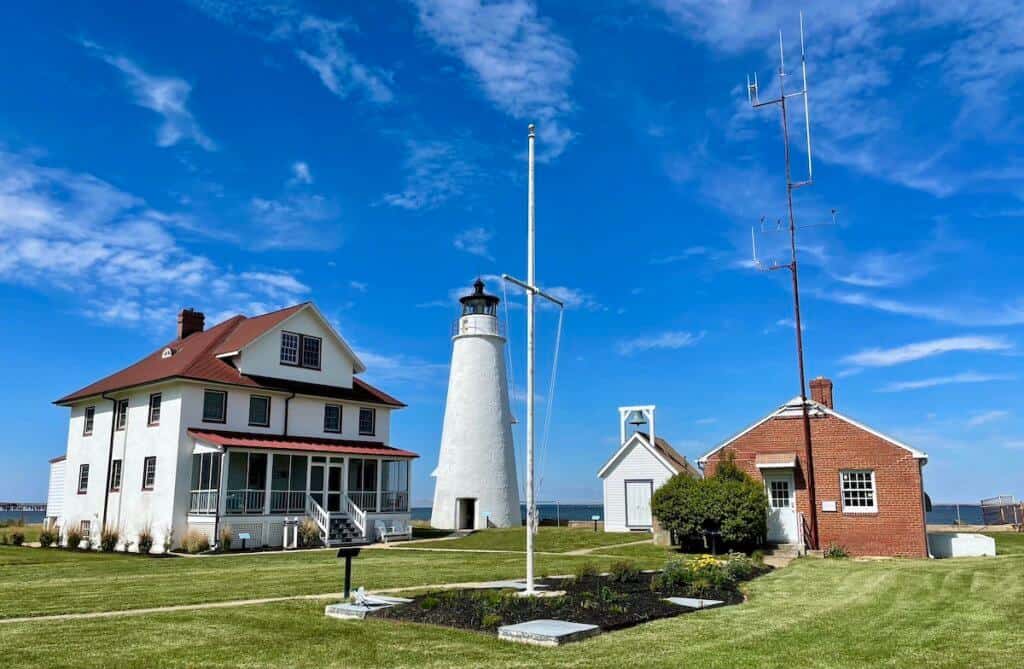
While you are not able to climb in the lighthouse, you can enter its base and visit the small adjacent museum. There’s a short video giving background on the lighthouse as well as related artifacts in the museum. Plus a museum interpreter can explain the workings of the lighthouse including the radio beacon clocks on display. When we visited, we gained an overview of the life of a lighthouse keeper. Also, we heard some interesting tidbits like how the keeper had to keep a log of all the vessels going up (and down) the bay and report those findings up to the Baltimore Maritime Exchange, so that city’s dock masters knew when to expect incoming ships. In addition, we learned about the technology and work involved in maintaining the lighthouse during all sorts of weather including fog and storms.
Check online for hours of operation; open to the public on some afternoons throughout the year. 3500 Lighthouse Boulevard, Lusby, MD
Drum Point Lighthouse
Located at the Calvert Marine Museum since 1975, the Drum Point Lighthouse is a screw pile, hexagonal cottage-type lighthouse that was once situated in the Chesapeake Bay. It was built in 1883 and in use until 1962 when it was decommissioned. Today visitors can climb the ladder and walk around inside the lighthouse to view the furnishings and imagine what life was like for the keeper. (I highly recommend visiting this if you’re interested in this piece of local history. Can you just imagine what it must have been like to be inside this wooden structure tending the lighthouse out in the bay during violent storms?)
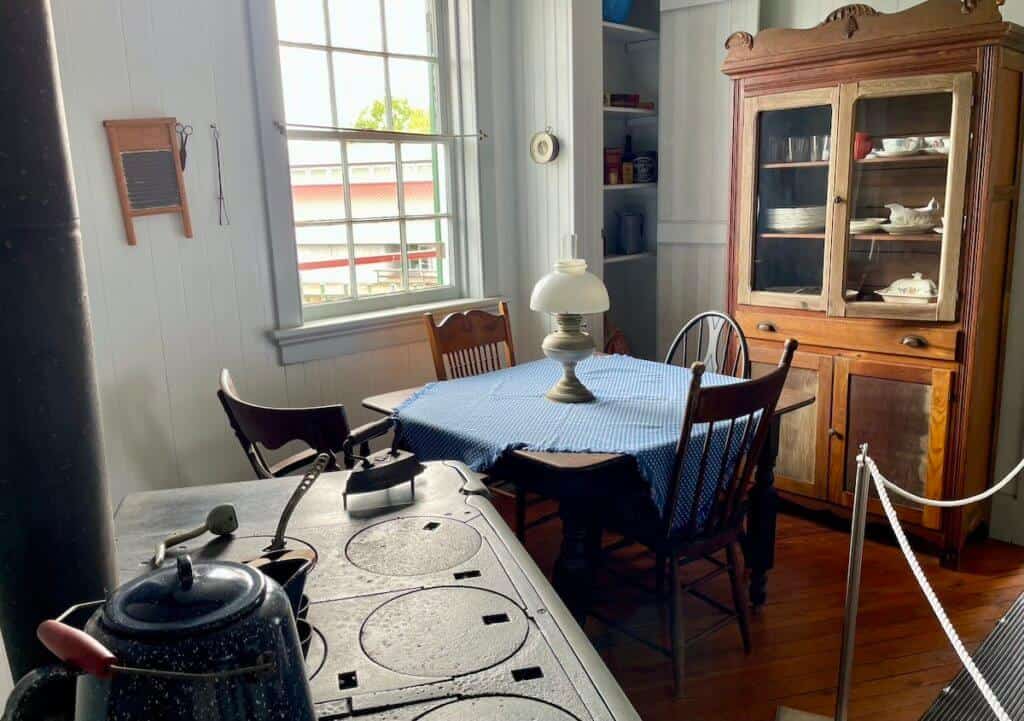
Located at Calvert Marine Museum: 4200 Solomons Island Road, Solomons, MD / 410-326-2042
Piney Point Lighthouse, Museum & Historical Park
Built in 1836, Piney Point Lighthouse is the oldest lighthouse on the Potomac River and is located 14 miles from the Chesapeake Bay. During World War II, the U.S. Navy used the surrounding area to test torpedoes that were built in Alexandria, Virginia. The lighthouse was decommissioned in 1964; St. Mary’s County acquired the property in 1980 and runs the museum today.
Piney Point Lighthouse stands on 6 acres that include the Keeper’s House, a museum, some historic wooden boats, a picnic area, a sandy beach (not for swimming or fishing), a kayak launching area, and the U1105 Historic Shipwreck Dive Preserve.
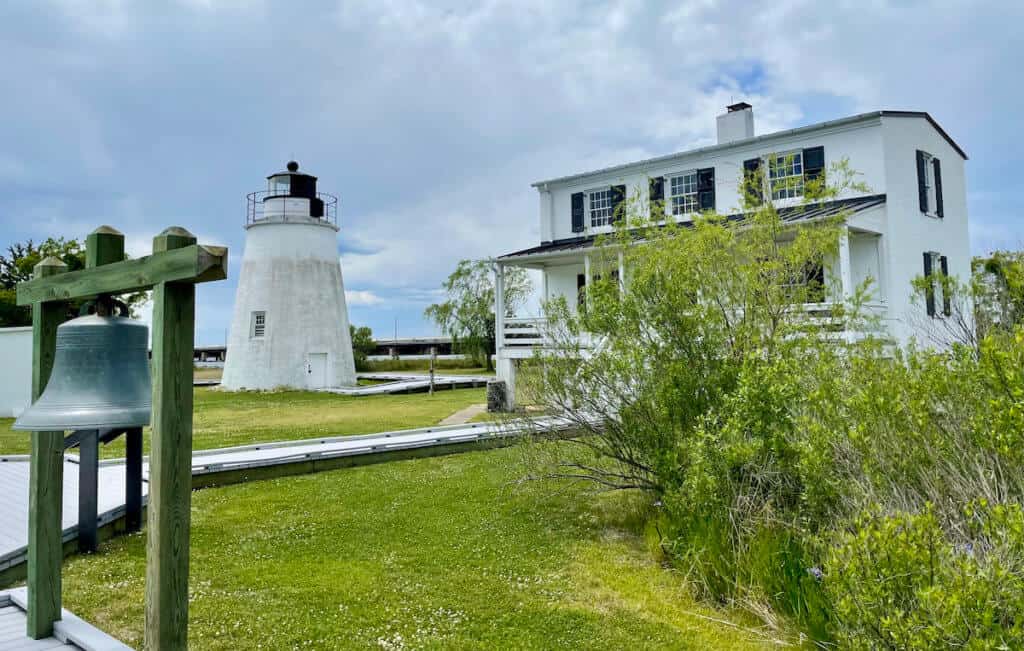
The Piney Point Lighthouse Museum
The museum presents interesting information about the lighthouse and its keepers. (Although lighthouse keepers were traditionally men, there were several women keepers here at Piney Point. Profiles of the various keepers are part of the museum’s displays.) Also, there’s an exhibit about a World War II Black Panther German submarine (that is now part of the shipwreck dive preserve).
Furthermore, there’s a display about the area as a popular summer resort for wealthy folks, many looking to escape the stifling heat in and around Washington, D.C. That vacation destination, beginning in the early 19th century and lasting for a little over 100 years, included Piney Point Hotel, guest cottages, a dance hall, a barbershop, and a steamboat wharf.
Informally known by some as the “Lighthouse of Presidents,” the area was visited by such 19th-century notables as Presidents James Monroe, Millard Filmore, Franklin Pierce, and Theodore Roosevelt.
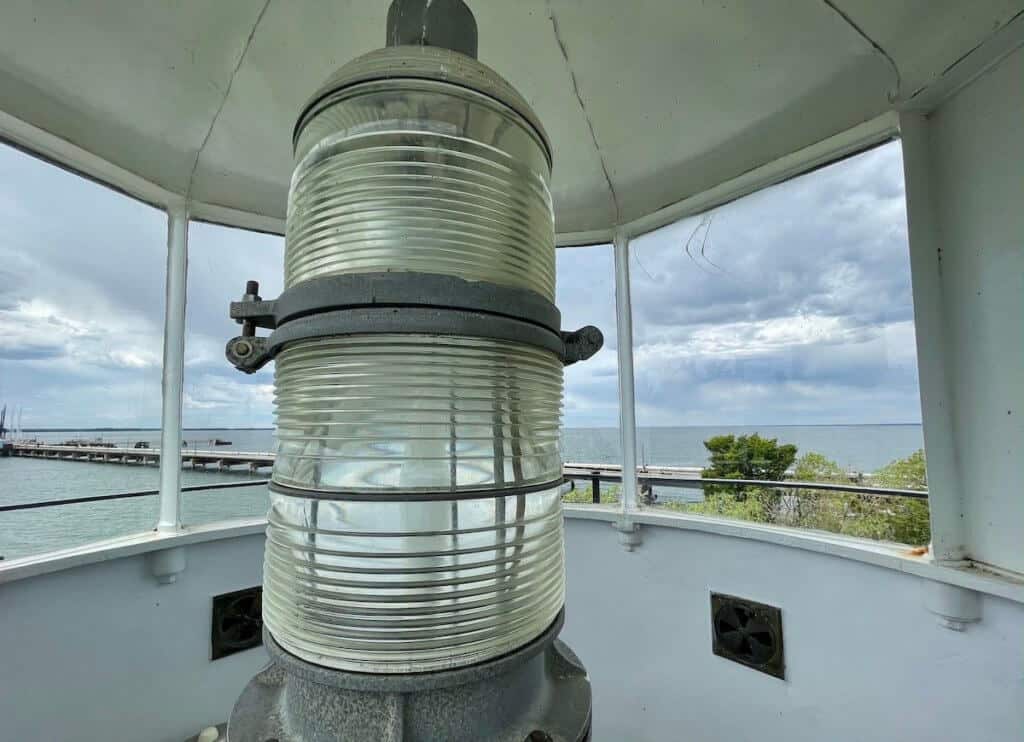
Touring the Piney Point Lighthouse
A museum guide at the lighthouse will explain details about its operation as you ascend the stairs and enjoy the 360-degree views from the top. The tour also includes entrance to the adjacent Keeper’s House.
Admission charged. 44720 Lighthouse Road, Piney Point, MD / 301-994-1471
Point Lookout State Park
Located on the southernmost point on the western Maryland shore, Point Lookout State Park includes the Point Lookout Lighthouse, built in 1830, as well as a public beach, a fishing pier, a boat launch site, campsites, and U.S. Civil War historical remains. It’s on a peninsula between the Potomac River and the Chesapeake Bay.
Aptly named because of its role as a lookout point during the War of 1812, Point Lookout later became a popular summer resort with a hotel, cottages, and a wharf. It also figured prominently during the U.S. Civil War. In 1862, the area on the Point was used as a U.S. Army hospital and a Union prisoner of war camp holding over 50,000 Confederate soldiers. Today a monument to those soldiers can be seen upon entering the park, and a museum helps tell the story of that point in history.
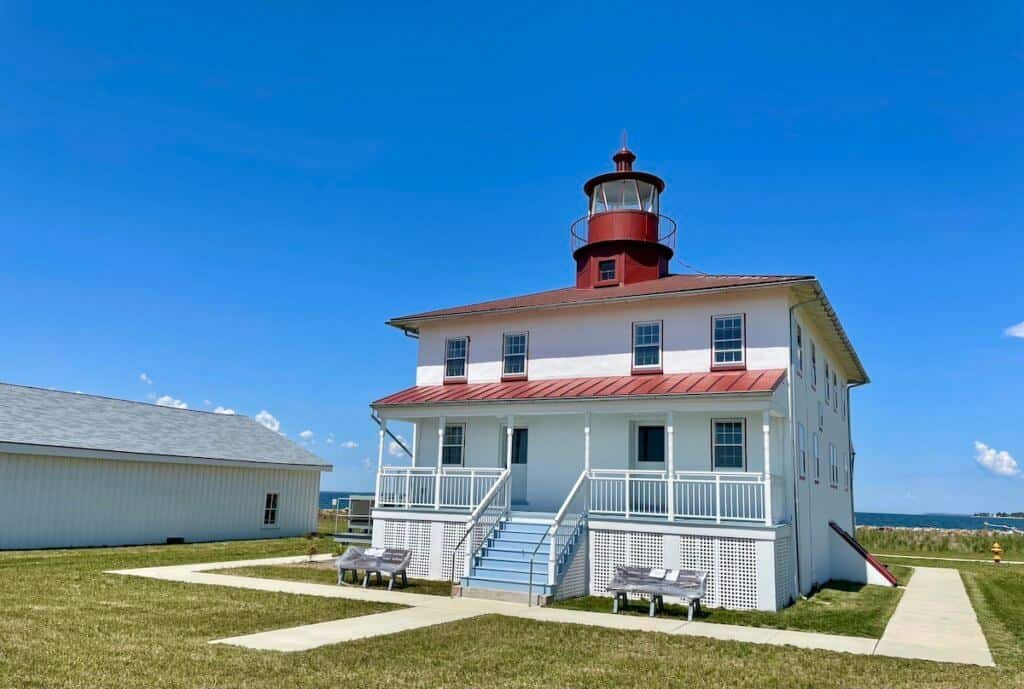
Adjoining the lighthouse is the keeper’s house which was enlarged over time to accommodate the keeper’s assistant (and both families, too). The lighthouse was deactivated in 1966. The state of Maryland acquired the lighthouse and its surrounding property in 2006.
Check ahead of your visit to learn the status of Point Lookout Lighthouse and keeper’s house as its renovation was underway in 2021. (When we visited, we weren’t able to venture inside, but we did enjoy a walk on the grounds around the structure and the adjacent buoy repair depot.) The park has plenty of other attractions to enjoy during your visit.
Admission charged. 11175 Point Lookout Rd, Scotland, MD / 301- 872-5688
4. Patuxent (PAX) River Naval Air Museum
Step inside the PAX River Naval Air Museum and you’ll learn about the U.S. Navy’s research, development and testing of planes as well as the resulting naval aircraft that have served the country from the beginning. There are about two dozen planes to view — both inside and outside the exhibition hall. The earliest is a recreation of the 1911 Curtiss A-1 Triad, the Navy’s first plane, and spanning generations of aircraft to the actual test plane for the Navy’s current F-35. Informational signs provide the context of who flew the planes, where they were flown, and when they were retired. Interestingly, there’s also an exhibit about aviation ideas that never made it to production (for a variety of factors). Flight simulators and a gift shop are also on-site.
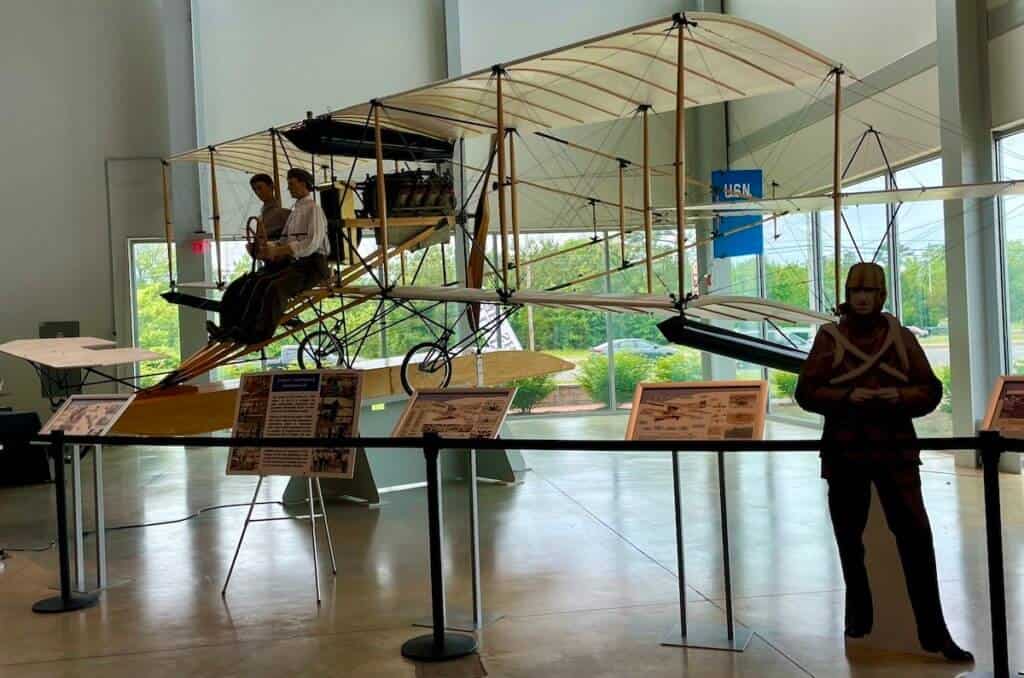
Admission charged. 22156 Three Notch Road, Lexington Park, MD / 301-863-1900.
5. Calvert Cliffs State Park
Unique to this area, Calvert Cliffs State Park’s highlight are the towering cliffs that were formed over 10 million years ago. Today it’s a 1,400 state park and a place to enjoy the sandy beach, fishing, picnicking, the playground — and a chance to hunt for fossils on the beach. There are said to have been over 600 species of fossils here. Pick one of several trails to walk; two take you to the beach: the Red Trail is an out-and-back path at 4 miles, and the Red and Orange Loop Trail is 4.5 miles. Expect to see some wildlife like turtles, lizards, and beavers — and for it to be buggy in the warm months. Open year-round, sunrise to sunset; leashed dogs are welcome.
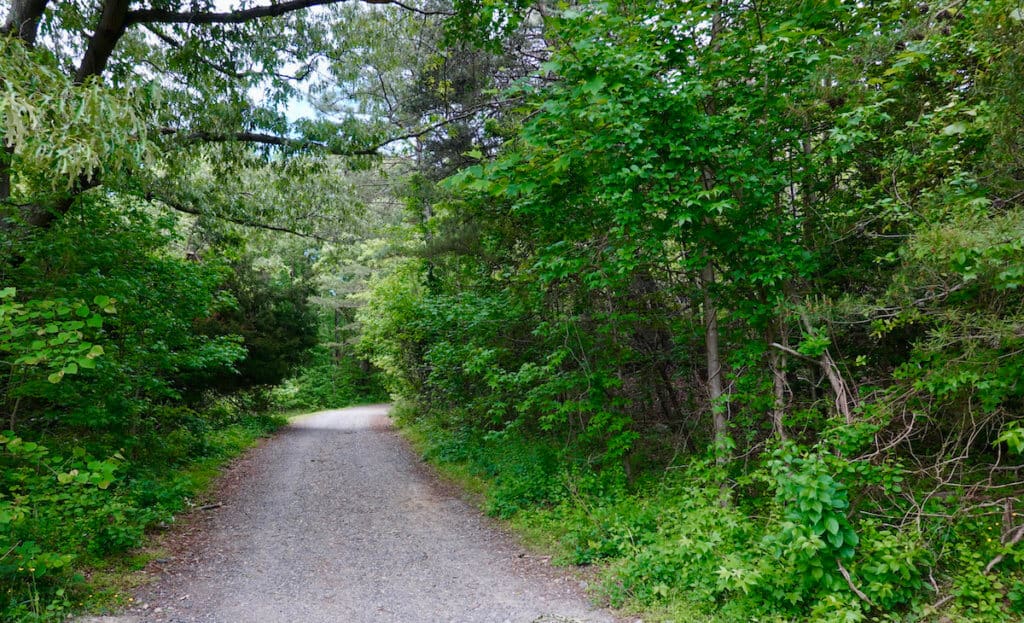
Admission is charged (by vehicle). 10540 H.G. Trueman Road, Lusby, MD / 443-975-4360
6. Solomons Island
Solomons Island is a welcome place to take a break from your explorations and enjoy some dining and shopping. Given a choice of restaurants, I prefer to eat somewhere with inviting menus and atmosphere. For me in Solomons Island, atmosphere means a place overlooking the water (rather than along a street). There are several choices of waterside restaurants in town, and I recommend The Island Hideaway as well as the Lighthouse Restaurant and Dockbar; both serve good food and provide diners with relaxing views of the comings and goings of a variety of boats along Back Creek. (Although these spots are at the top of my list, there are plenty of other great dining spots nearby.)
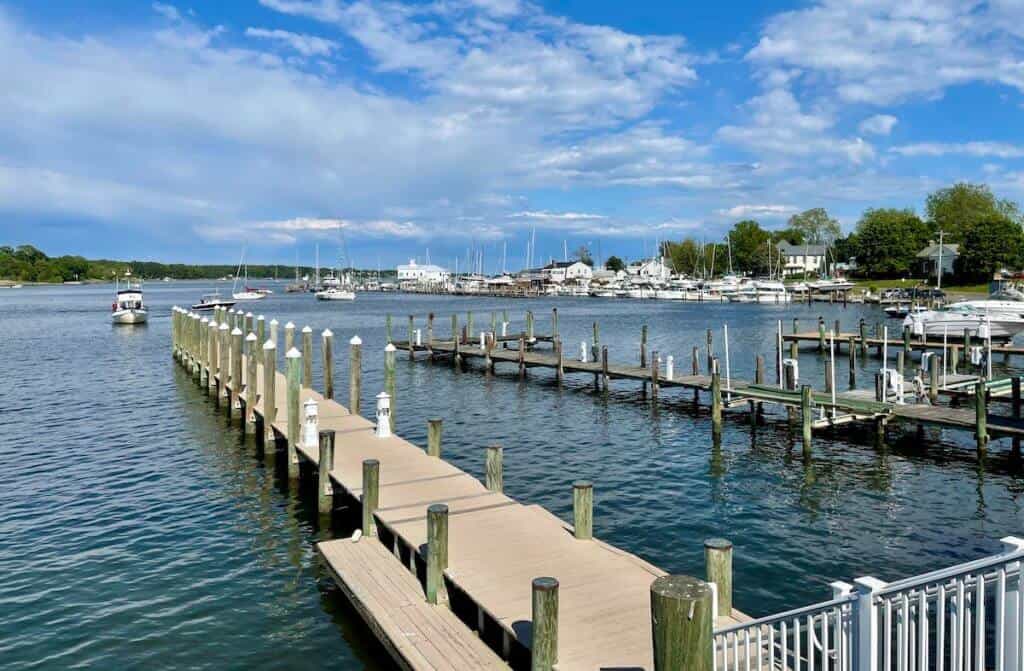
Where to Stay
One of the dilemmas I always face when we travel is finding a lovely inn or hotel to relax in while away from home. After a bit of research, my husband and I settled on The Swanendele Inn, located in Ridge, MD. It is set right on the water with amazing views (sunrises and sunsets are spectacular!), has well-appointed guest rooms and plenty of relaxing spaces, three delightful innkeepers, and scrumptious breakfasts. You can even schedule Chef Miguel, one of the innkeepers, to prepare a private dinner. We did, and you should, too.
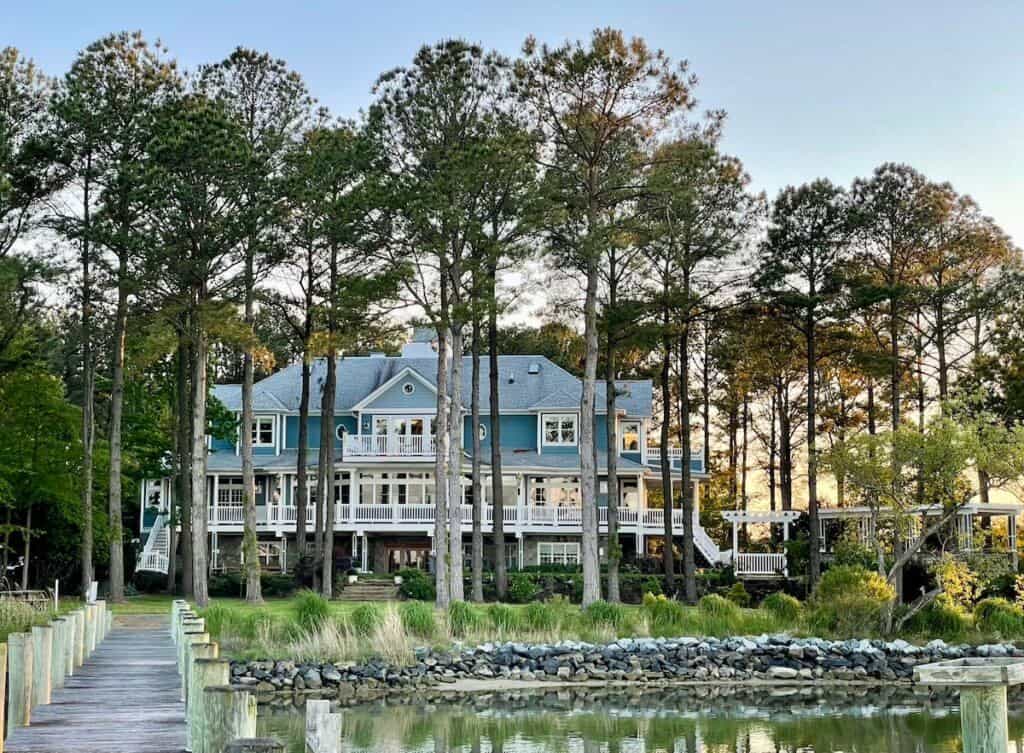
Nearby Attractions
The charming, historical city of Annapolis is less than a two-hour drive away. If time permits, consider coupling a visit to Historic St. Mary’s City (15 minutes from the inn) in southern Maryland with a stop in Annapolis. This northern city was the up-and-coming port city of the 17th century that lured many of the townspeople away from St. Mary’s City — leading to its eventual decline. Read the Annapolis visitor guide to get the most out of your stay there.
Final Thoughts
My husband and I had a great time exploring this special part of southern Maryland. Historic St. Mary’s City is a premier historical and archeological site that presents so much interesting early American history. And who can resist the lure of lighthouses, those sentinels guiding mariners from danger? We learned something new at each lighthouse and came to really appreciate the role that lighthouse keepers played in keeping the waterways safe for ships and their crews. And the museums and parks were a pleasure to visit, learn something new and enjoy the beauty of nature. All in all, the places we visited fed our appreciation for history and nature (plus a little wine, too!).
Wine Time
If you have some free time, you might also want to check the Port of Leonardtown Winery. The winery is one of only two wine cooperatives in the U.S. They produce a variety of red, white, and rose wine using grapes from 12 nearby vineyards. This winery has plenty of outdoor seating along a creek, and musical guests perform on some weekends. We stopped by, had a tasting, and bought two bottles that we enjoyed when we returned home. Delicious memories of our trip! 23190 Newtowne Neck Road, Leonardtown, MD / 301-690-2192
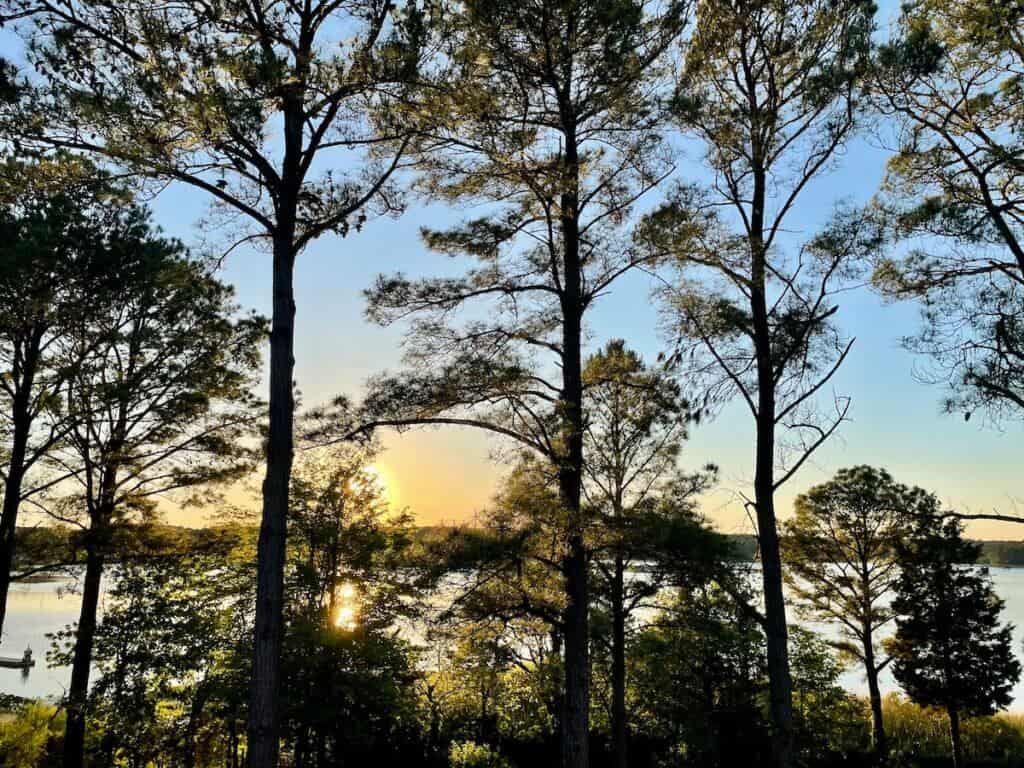
Comments?
Feel free to leave a comment about other great spots to visit on the western shore of southern Maryland. Your ideas could help others who plan to visit the area. 🙂

